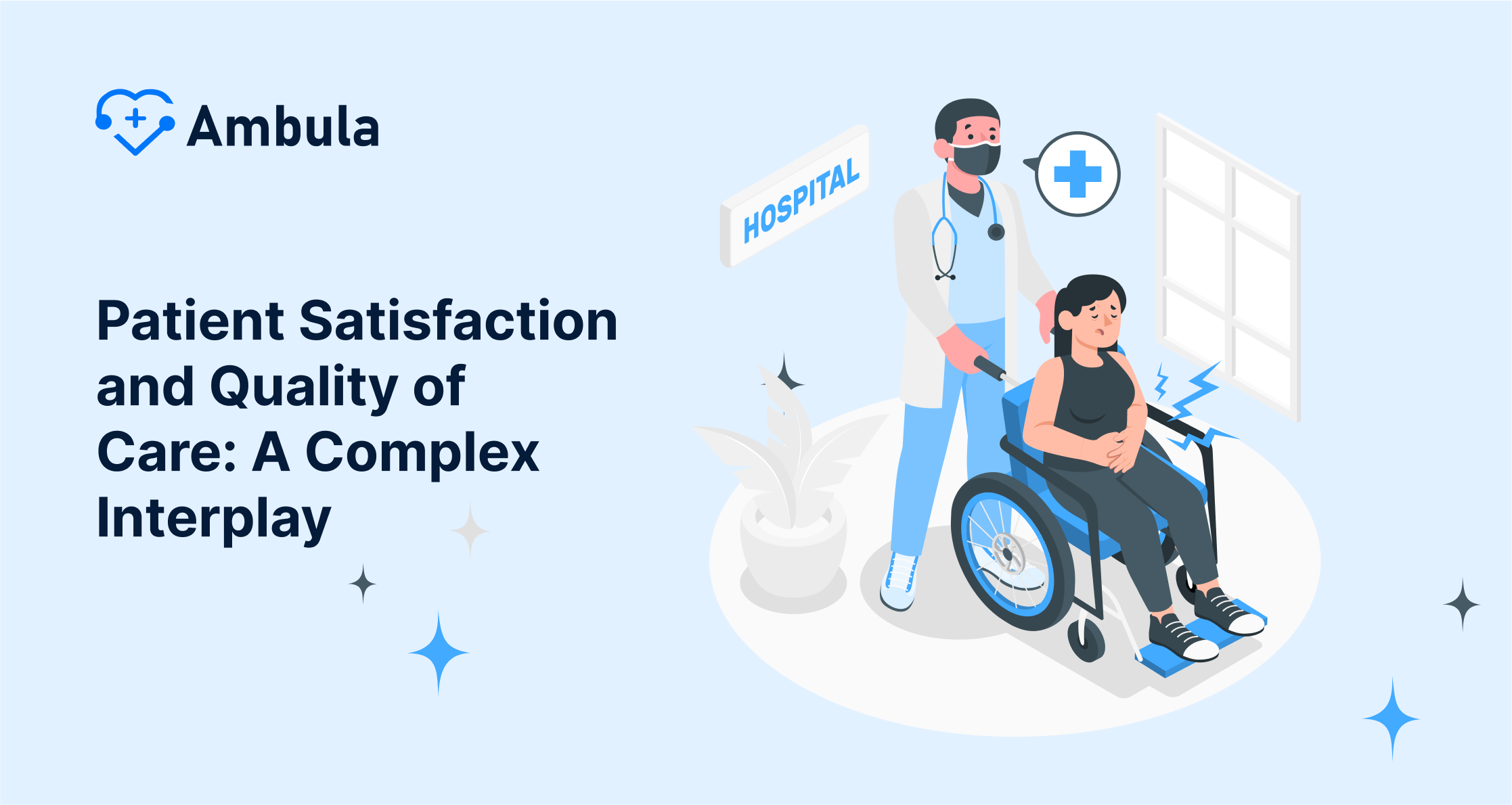What is patient satisfaction in healthcare?
Patient satisfaction is a significant measure in modern healthcare. It determines the quality of healthcare delivered and impacts the patient experience. Patients who feel satisfied with their treatment tend to have enhanced patient engagement, leading to a better health outcome. Moreover, good medical care that focuses on educating patients and understanding their medical needs often ranks high in patient satisfaction. Therefore, every healthcare facility, whether a doctor’s office or a hospital, should strive to meet and surpass patient expectations.
The positive implication of high patient satisfaction doesn’t end with patient education and engagement. It also contributes to patient loyalty, a crucial factor for any healthcare provider. Additionally, satisfied patients are more likely to comply with the recommended treatments, enhancing clinical outcomes and possibly reducing the likelihood of malpractice suits.
Patient Satisfaction and Quality of Care: A Complex Interplay
Patient satisfaction and quality of care are intricately connected, forming a crucial aspect of healthcare delivery. While not always directly correlated, understanding their relationship is essential for improving patient outcomes and overall healthcare experience.
Patient satisfaction refers to the individual’s perception of the care they receive, encompassing various elements like:
- Technical quality: Effectiveness of treatment and clinical skills of healthcare providers.
- Interpersonal aspects: Communication, respect, and empathy shown by healthcare professionals.
- Organizational aspects: Wait times, accessibility, and overall healthcare facility environment.
On the other hand, quality of care refers to the objective measure of how well healthcare services are delivered, adhering to established standards and best practices. It encompasses:
- Clinical outcomes: Improved health status, reduced complications, and adherence to evidence-based guidelines.
- Patient safety: Avoiding preventable harm and ensuring patient well-being throughout healthcare.
- Efficiency and resource utilization: Optimizing resource allocation and minimizing waste while delivering effective care.
While high-quality care often leads to increased patient satisfaction, it’s not always a guaranteed outcome. Factors like individual expectations, cultural differences, and communication styles can influence perception. Conversely, high patient satisfaction can be influenced by non-clinical factors like the comfort of the environment or the attentiveness of staff, not necessarily reflecting the technical quality of care.
Despite these complexities, patient satisfaction remains a valuable indicator of healthcare quality. It provides valuable feedback on the patient experience, highlighting areas for improvement and identifying potential gaps between perceived and actual quality.
The Influence of the Waiting Room and Receptionist on Patient Satisfaction
Upon entering a hospital, patients interact with the receptionist and the waiting room. These initial interactions can significantly influence their overall impression of the healthcare service received. A warm, welcoming receptionist who communicates effectively sets a positive tone for the subsequent interactions.
Patient’s perception of cleanliness and the comfort of the waiting room also influences their satisfaction. Internet access and reading materials can keep them occupied during the wait time, enhancing the patient experience. Thus, the waiting room’s ambiance and the receptionist’s interpersonal skills are crucial.
The Role of the Exam Room and Medical Staff
Once beyond the waiting room, patient interactions with the nurse, medical assistant, and physician further shape patient satisfaction. Effective communication, professional attire, and timeliness become critical pieces in this puzzle.
The medical assistant and the nurse must ensure the exam room’s cleanliness and conduct themselves professionally, putting patients at ease. They must also clearly explain lab results and educate patients about their condition and the necessary measures they need to take. The physician, on the other hand, should engage the patient in the decision-making process. Furthermore, evidence-based practice can enhance patient satisfaction through better clinical outcomes and pain management.
Incorporating Patient Feedback
Patient feedback is a valuable tool in healthcare that aids in enhancing patient satisfaction, care quality, and overall health outcomes. It broadens the scope of better understanding patients’ expectations, needs, and experiences. Gathering this feedback provides insights into the good aspects of medical care and the areas requiring improvement.
Healthcare professionals can invite feedback through various methods, such as surveys or interviews. One effective approach is posing open-ended questions. This strategy allows patients to fully express their thoughts, feelings, and experiences, thus offering an in-depth understanding of their expectations and perceptions.
Postoperative pain and complications are among areas where patient feedback is particularly useful. Assessing patient feedback enables healthcare providers to design and implement interventions to manage these effectively. Studies have shown that effective pain management strategies significantly improve patient satisfaction. For instance, sufficient postoperative pain management can prevent complications, hasten recovery, and reduce hospital stay duration, ultimately enhancing the patient experience.
Dealing with Patient Expectations and Satisfaction Measures
Patient expectations are integral to their healthcare experience, and managing these effectively can significantly enhance their satisfaction. Expectations refer to what patients anticipate regarding different elements of their healthcare journey, including communication, medical care quality, and overall experience. Understanding these expectations is key to delivering care that meets or surpasses them.
However, patient expectations can vary widely, influenced by many factors such as past experiences, perceived service quality, and publicly available information about healthcare providers. Therefore, a better understanding of these expectations is essential. Healthcare providers can uncover patient expectations through direct communication, surveys, or feedback systems.
When identified, these expectations need to be properly managed. Patients who feel heard and understood will likely feel more comfortable, cooperative, and satisfied. For healthcare providers, meeting these expectations can result in higher patient satisfaction scores and boost patient loyalty and trust.
Patient satisfaction scores
To truly understand what makes your patients happy, you need to go beyond assumptions and gather their valuable feedback. Here’s how to effectively measure your patient satisfaction scores and turn insights into action:
Metrics that Matter
- Calculate Scores: Analyze survey data to track key metrics like Patient Satisfaction Scores (PSS) and Net Promoter Scores (NPS), revealing overall satisfaction levels and potential areas for improvement.
- Benchmark and Compare: Benchmark your scores against industry standards and compare them across different departments or providers to identify areas for targeted interventions.
- Close the Loop: Share Feedback and Results: Share anonymized feedback with staff and providers, fostering accountability and prompting discussions on improvement strategies.
Remember: Measuring patient satisfaction is an ongoing process, not a one-time event. By utilizing diverse feedback methods, actively engaging with patients, and effectively analyzing data, you can translate insights into real-world improvements, continuously raising the bar for patient satisfaction and building lasting trust.
The Impact on Healthcare Consumers and Strategies for Improvement
In today’s digital age, patients play the dual role of being healthcare consumers. They actively seek information, compare services, and make informed choices about their healthcare providers. Internet and social media platforms have greatly changed the patient-provider dynamic. Physician ratings, patient testimonials, and online reviews significantly influence a patient’s decision to choose a specific physician or hospital.
High patient satisfaction ratings can strengthen a provider’s reputation, enhancing patient trust and loyalty. As more patients share their positive experiences online, it works as an effective referral system, attracting new patients and retaining existing ones. However, this also means that negative experiences can deter potential patients, underscoring the importance of optimal patient care.
To ensure improved patient satisfaction ratings, healthcare providers must implement effective strategies. Clear and empathetic communication can greatly increase a patient’s understanding of their course of treatment and a sense of involvement, leading to higher satisfaction. Regular training programs for all staff members can also help optimize the patient’s journey from the reception to the exam room.
2021 Survey Reveals Key Areas of Patient Satisfaction
This survey studied patient satisfaction across different hospitals in the United States, identifying top and bottom-scoring areas. The survey further analyzed variations in patient satisfaction by hospital types and patient demographics, revealing distinct trends in feedback among certain patient groups and hospital settings.
- According to a 2021 survey by the American Hospital Association, the average patient satisfaction score for hospitals in the United States is 73.4 out of 100.
- The top three areas of patient satisfaction are:
- Communication with doctors (80.2%)
- Pain management (77.8%)
- Cleanliness of the hospital (76.9%)
- The bottom three areas of patient satisfaction are:
- Communication with nurses (72.6%)
- Discharge planning (70.7%)
- Overall satisfaction with the hospital (70.6%)
- Patient satisfaction scores vary by hospital type, with academic medical centers typically having lower scores than community hospitals.
- Patient satisfaction scores also vary by patient demographics, with older patients and patients with lower incomes typically having lower scores.
Christy Dempsey, chief nursing officer of Press Ganey Associates, in her interview with the Center to Advance Palliative Care. says :
“When you think about ‘patient satisfaction’, your mind may automatically go to the superficial: making patients happy and being nice. ‘Patient experience’ is the totality of the experience. The clinical, operational, cultural, and behavioral – everything that happens to, about, and with the person who happens to be a patient.”
Concluding Thoughts on Patient Satisfaction
Patient satisfaction significantly shapes the course of the healthcare sector. It determines the quality and effectiveness of medical care while greatly influencing patient loyalty and outcomes. Hence, every medical professional, from the receptionist to the physician, has a role in ensuring a happy patient. Strategies that enhance patient education, engagement, and care quality can ensure patient satisfaction.









